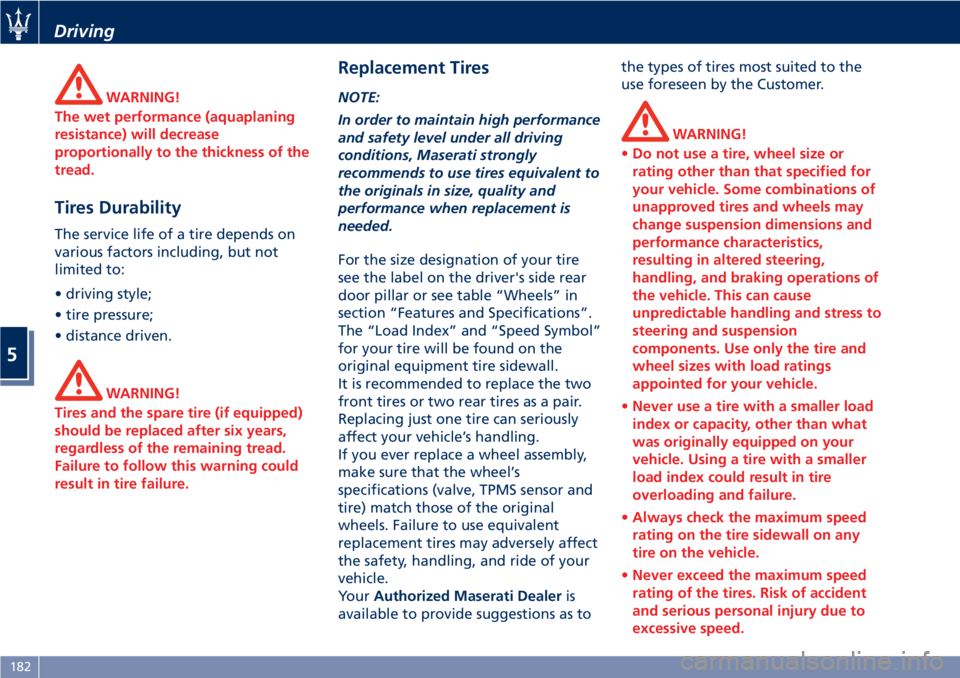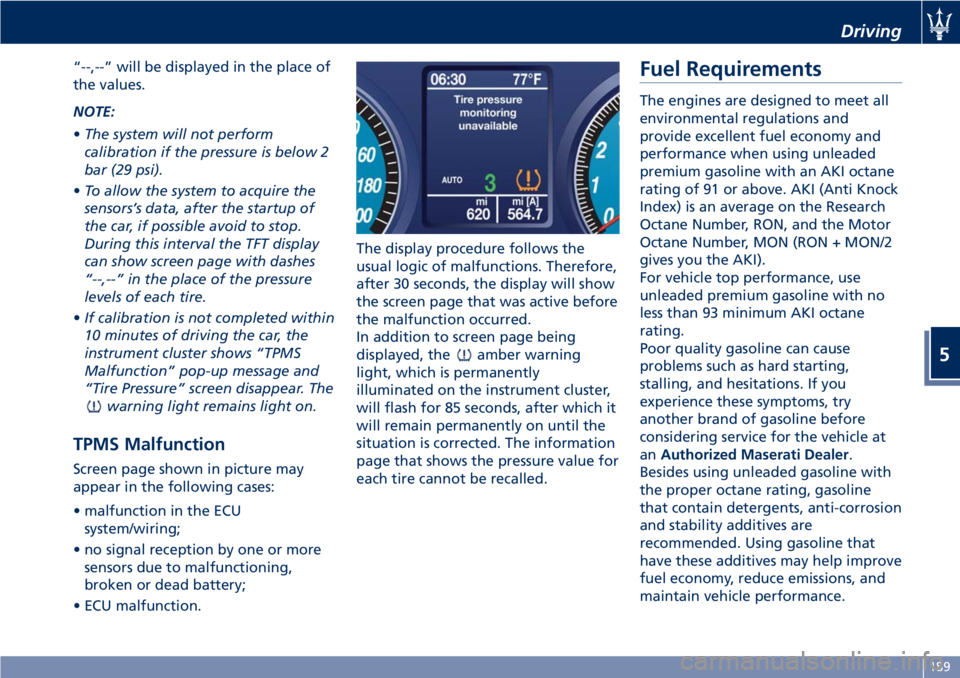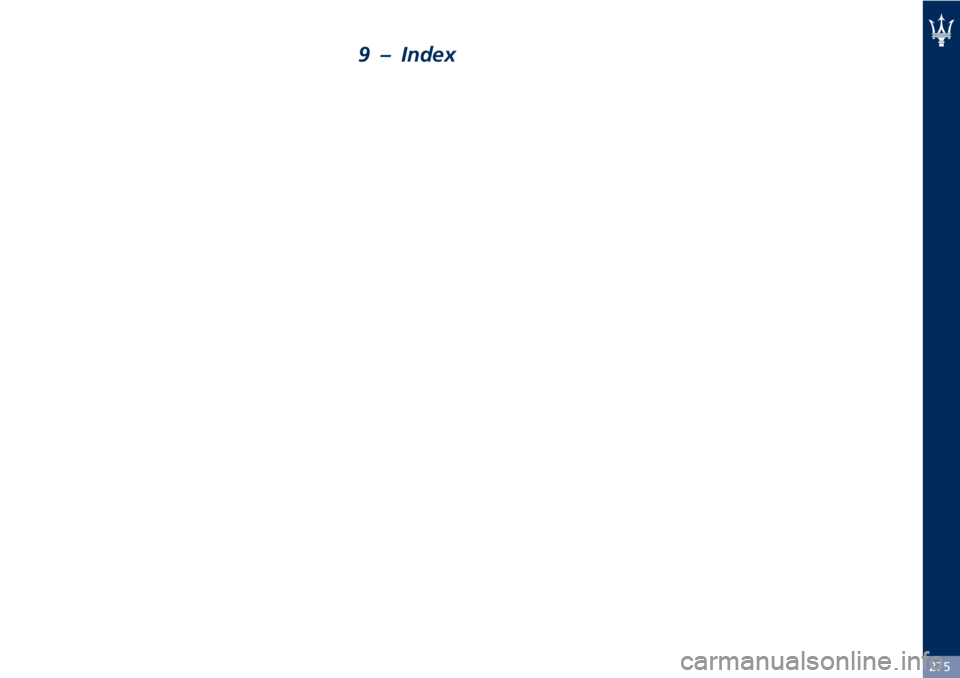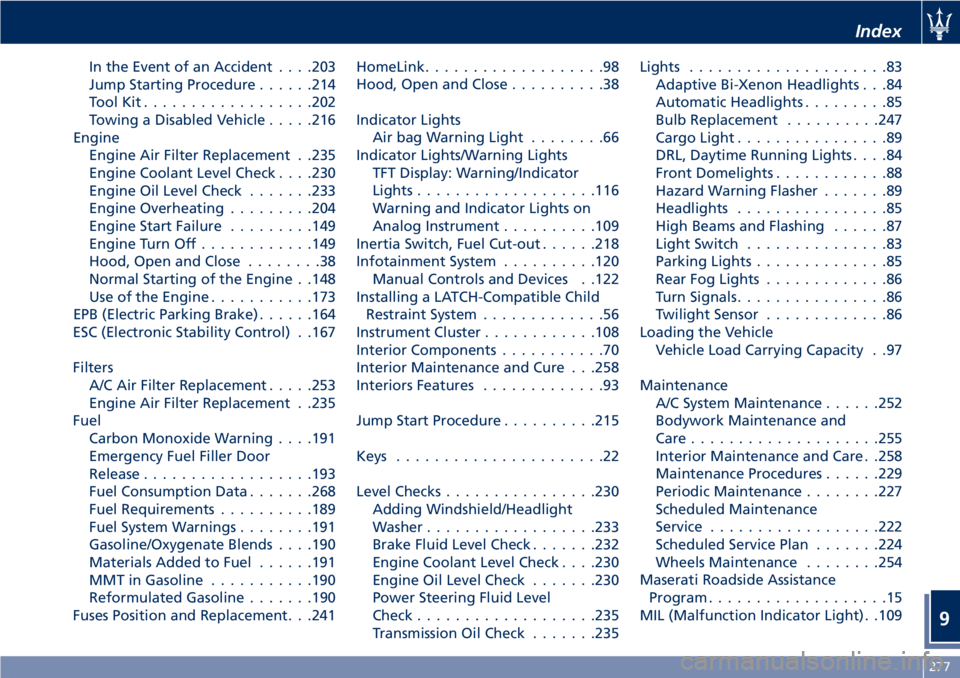Index MASERATI GRANTURISMO 2019 Owners Manual
[x] Cancel search | Manufacturer: MASERATI, Model Year: 2019, Model line: GRANTURISMO, Model: MASERATI GRANTURISMO 2019Pages: 286, PDF Size: 8.08 MB
Page 7 of 286

Introduction
Before Starting
Understanding the Vehicle
Dashboard Instruments and Controls
Driving
In an Emergency
Maintenance and Care
Features and Specifications
Index 1
2
3
4
5
6
7
8
9
3
Page 18 of 286

Vehicle using lead-free
gasoline
Only “Premium gasoline”
with an AKI (Anti Knock
Index) rating not lower
than 91 (approximately 96
R.O.N.) must be used. Refer
to chapter "Fuel
Requirements" in section
"Driving".
WARNING!
California Proposition 65
Operating, servicing and maintaining
a passenger vehicle or off-road vehicle
can expose you to chemicals including
such as, engine exhaust, carbon
monoxide, phthalates and lead, that
which are know to the State of
California to cause cancer and birth
defects or other reproductive harm. To
minimize exposure, avoid breathing
exhaust, do not idle the engine except
as necessary, service your vehicle in a
well-ventilated area and wear gloves
or wash your hands frequently when
servicing your vehicle. For more
information go to:
www.P65Warnings.ca.gov/passenger-
vehicle Warnings when driving Your driving skills will improve with
experience, but be especially careful at
the beginning. Always comply with
local traffic regulations wherever you
drive.
Failure to operate this vehicle correctly
may result in loss of control or a
collision.
Operating this vehicle at excessive
speed or in an altered state or while
intoxicated may result in loss of
control, going off the road, or
overturning. In all these situations a
collision with other vehicles or objects
is more likely to happen with the risk
to cause an accident that may lead to
serious injury.
In case of an accident, failure to use
seat belts causes the driver and
passengers a greater risk of injury or
death.
This Owner's Manual contains
warnings against operating procedures
that could result in a collision or injury
or damage to the environment. It also
contains cautions against procedures
that could damage the vehicle.
If you do not read this manual in its
entirety, you may miss important
information. Consider carefully all
warnings and cautions. WARNING!
• It is the driver’s responsibility to
operate the vehicle in a safe way: if
you are distracted while driving you
can lose control and cause serious
accidents.
• Maserati strongly recommends to
use particular care when operating
the features and tools that may take
the attention off the road.
• Mobile phones, PC, portable audio
device or other features should not
be operated while the vehicle is in
motion. This can be very dangerous
and can cause serious accidents.
• It is very dangerous to send text
messages while driving, do so only
when the vehicle is not moving.
• In some Countries/States the use of
mobile phone when driving is
forbidden: it is the driver’s sole
responsibility to respect local
regulations.
CAUTION!
If battery charge is too low, proper
function of some electric/electronic
components may not be guaranteed. ItIntroduction
1
14
Page 60 of 286

NOTE:
For additional information, refer to
www.seatcheck.org or call
1–866–SEATCHECK. Canadian residents
should refer to Transport Canada’s
website for additional information:
http://www.tc.gc.ca/roadsafety/
safedrivers/childsafety/index.htm
WARNING!
• Improper installation can lead to
failure of an infant or child restraint.
It could come loose in a collision. The
child could be badly injured or killed.
Follow the restraint manufacturer’s
directions exactly when installing an
infant or child restraint.
• A rearward-facing child restraint
should only be used in a rear seat. A
rearward-facing child restraint in the
front seat may be struck by a
deploying passenger air bag, which
may cause severe or fatal injury to
the infant.
Here are Some Tips on Getting
the Most Out of Your Child
Restraint
• Before buying any restraint system,
make sure that it has a label certifying that it meets all applicable
Safety Standards. Maserati also
recommends that you make sure that
you can install the child restraint in
the vehicle where you will use it
before you buy it.
• The restraint system must be
appropriate for your child’s weight
and height.
• Check the label on the restraint
system for weight and height limits.
• Carefully follow the instructions that
come with the restraint system.
• If installed improperly, it may not
work when needed.
• Fit the child into the seat according
to the child restraint manufacturer’s
directions.
WARNING!
When your child restraint system is
not in use, secure it in the vehicle with
the seat belt or remove it from the
vehicle. Do not leave it loose in the
vehicle. In a sudden stop or accident, it
could strike the occupants or
seatbacks and cause serious personal
injury. Installing Child Restraint
Systems using the Vehicle Seat
Belt equipped with ALR All the passenger seat belts are
equipped with an Automatic Locking
Retractor (ALR) to secure child
protection through a Child Restraint
System (CRS). These types of seat belts
are designed to keep the lap portion
of the seat belt tight around the child
restraint seat avoiding to use a locking
clip.
The ALR will make a ratcheting noise if
the entire belt is pulled out of the
retractor in order to enable the belt to
retract subsequently. For additional
information on ALR, see “Using Seat
Belt in Automatic Locking Retractor
(ALR) Mode” in “Occupants Restraint
Systems” in this section.
To install a Child Restraint System with
ALR, pull enough of the belt out of the
retractor leading it through the belt
path of the protection device. Slide the
latch into the buckle until it clicks,
then remove the entire safety belt
from the retractor in order to
rewound. While rewinding a click will
indicate the safety belt is now in
Automatic Locking mode.
Exert then a traction on the exceeded
lap section of the belt in order toBefore Starting
2
56
Page 182 of 286

Tire Sizing Chart
EXAMPLE: P285/40 ZR19 (100Y) XL or
285/40 ZR19 (Y100) XL
Size Designation:
P = Passenger car tire size based on
U.S. design standards
“...blank...” = Passenger car tire
based on European design standards
285 = Section width in millimeters
(mm)
40 = Aspect ratio in percent (%) —
Ratio of section height to section
width of tire
ZR = Construction Code
• Z: means a tire usable at speeds
greater than 150 mph (240 km/h)
• R: means radial construction
19 = Rim diameter in inches (in) Service Description:
100 = Load Index — A numerical
code associated with the maximum
load a tire can carry
Y = Speed Symbol — A symbol
indicating the range of speeds at
which a tire can carry a load
corresponding to its load index
under certain operating conditions.
The maximum speed corresponding
to the speed symbol should only be
achieved under specified operating
conditions (i.e., tire pressure, vehicle
loading, road conditions, and posted
speed limits)
Load Identification:
“...blank...” = Absence of any text on
the sidewall of the tire indicates a
Standard Load (SL) tire
XL = Extra Load (or reinforced) tire
LL = Light Load tire
Tire Identification Number (TIN)
The TIN may be found on one or both
sides of the tire, however the date
code may only be on one side. Tires
with white sidewalls will have the full
TIN, including the date code, located
on the white sidewall side of the tire. Look for the TIN on the outboard side
of black sidewall tires as mounted on
the vehicle. If the TIN is not found on
the outboard side, then you will find it
on the inboard side of the tire.
EXAMPLE: DOT MA L9 ABCD 0313
DOT = Department of Transportation
— This symbol certifies that the tire is
in compliance with the U.S.
Department of Transportation tire
safety standards and is approved for
highway use.
MA = Code representing the tire
manufacturing location (two digits).
L9 = Code representing the tire size
(two digits).
ABCD = Code used by the tire
manufacturer (one to four digits).
03 = Number representing the week
in which the tire was manufactured
(two digits). In this case, 03 means
the 3 rd
week.
13 = Number representing the year
in which the tire was manufactured
(two digits). In this case, 13 means
the year 2013.Driving
5
178
Page 186 of 286

WARNING!
The wet performance (aquaplaning
resistance) will decrease
proportionally to the thickness of the
tread.
Tires Durability The service life of a tire depends on
various factors including, but not
limited to:
• driving style;
• tire pressure;
• distance driven.
WARNING!
Tires and the spare tire (if equipped)
should be replaced after six years,
regardless of the remaining tread.
Failure to follow this warning could
result in tire failure. Replacement Tires NOTE:
In order to maintain high performance
and safety level under all driving
conditions, Maserati strongly
recommends to use tires equivalent to
the originals in size, quality and
performance when replacement is
needed.
For the size designation of your tire
see the label on the driver's side rear
door pillar or see table “Wheels” in
section “Features and Specifications”.
The “Load Index” and “Speed Symbol”
for your tire will be found on the
original equipment tire sidewall.
It is recommended to replace the two
front tires or two rear tires as a pair.
Replacing just one tire can seriously
affect your vehicle’s handling.
If you ever replace a wheel assembly,
make sure that the wheel’s
specifications (valve, TPMS sensor and
tire) match those of the original
wheels. Failure to use equivalent
replacement tires may adversely affect
the safety, handling, and ride of your
vehicle.
Your Authorized Maserati Dealer is
available to provide suggestions as to the types of tires most suited to the
use foreseen by the Customer.
WARNING!
• Do not use a tire, wheel size or
rating other than that specified for
your vehicle. Some combinations of
unapproved tires and wheels may
change suspension dimensions and
performance characteristics,
resulting in altered steering,
handling, and braking operations of
the vehicle. This can cause
unpredictable handling and stress to
steering and suspension
components. Use only the tire and
wheel sizes with load ratings
appointed for your vehicle.
• Never use a tire with a smaller load
index or capacity, other than what
was originally equipped on your
vehicle. Using a tire with a smaller
load index could result in tire
overloading and failure.
• Always check the maximum speed
rating on the tire sidewall on any
tire on the vehicle.
• Never exceed the maximum speed
rating of the tires. Risk of accident
and serious personal injury due to
excessive speed.Driving
5
182
Page 193 of 286

“--,--” will be displayed in the place of
the values.
NOTE:
• The system will not perform
calibration if the pressure is below 2
bar (29 psi).
• To allow the system to acquire the
sensors’s data, after the startup of
the car, if possible avoid to stop.
During this interval the TFT display
can show screen page with dashes
“--,--” in the place of the pressure
levels of each tire.
• If calibration is not completed within
10 minutes of driving the car, the
instrument cluster shows “TPMS
Malfunction” pop-up message and
“Tire Pressure” screen disappear. The
warning light remains light on.
TPMS Malfunction Screen page shown in picture may
appear in the following cases:
• malfunction in the ECU
system/wiring;
• no signal reception by one or more
sensors due to malfunctioning,
broken or dead battery;
• ECU malfunction. The display procedure follows the
usual logic of malfunctions. Therefore,
after 30 seconds, the display will show
the screen page that was active before
the malfunction occurred.
In addition to screen page being
displayed, the
amber warning
light, which is permanently
illuminated on the instrument cluster,
will flash for 85 seconds, after which it
will remain permanently on until the
situation is corrected. The information
page that shows the pressure value for
each tire cannot be recalled. Fuel Requirements The engines are designed to meet all
environmental regulations and
provide excellent fuel economy and
performance when using unleaded
premium gasoline with an AKI octane
rating of 91 or above. AKI (Anti Knock
Index) is an average on the Research
Octane Number, RON, and the Motor
Octane Number, MON (RON + MON/2
gives you the AKI).
For vehicle top performance, use
unleaded premium gasoline with no
less than 93 minimum AKI octane
rating.
Poor quality gasoline can cause
problems such as hard starting,
stalling, and hesitations. If you
experience these symptoms, try
another brand of gasoline before
considering service for the vehicle at
an Authorized Maserati Dealer .
Besides using unleaded gasoline with
the proper octane rating, gasoline
that contain detergents, anti-corrosion
and stability additives are
recommended. Using gasoline that
have these additives may help improve
fuel economy, reduce emissions, and
maintain vehicle performance. Driving
5
189
Page 279 of 286

9 – Index
275
Page 280 of 286

Abbreviations .................7
ABS (Anti-lock Braking System) . . .169
A/C Air Filter Replacement ...... .253
Accessories
Aftermarket Parts and Accessories
Statement .................11
Accident, in the event of ....... .203
A/C System Maintenance ....... .252
Airbag.....................47
Air bag System Components .....47
Air bag Warning Light .........66
Passenger Air bag Labels .......18
Supplemental Restraint System
(SRS) .....................47
Air Conditioning Controls ...... .140
Air Conditioning Distribution .... .101
Alarm, Vehicle Security ..........26
ALR (Automatic Locking Retractor) . .44
Assistance ....................9
Assistance, if you need .........9
Audio Controls .............. .128
Steering Wheel Audio Controls . .128
Audio, Customer Setting ....... .136
Audio System ............... .130
Automatic Transmission ....... .150
Automatic Transmission Range . .152
AUX, USB and SD Memory Card
Ports .................... .122
Battery ................... .237
Access the Battery .......... .215
Jump Start Procedure ....... .215
Maintenance - Free Battery . . . .237 To Disconnect the Battery .... .237
To Reconnect the Battery ..... .238
Bluetooth, Customer settings .... .137
Bodywork Maintenance and Care . .255
Protection from Atmospheric
Agents ................. .255
Useful Advice to Keep the
Bodywork in Good Condition . . .256
Brakes
Brake and Stability Control
System .................. .167
Brake Fluid Level Check ...... .232
Brake Overheating ......... .172
Parking Brake ............. .164
Parking Brake - Manual
Release ................. .209
Using the Brakes ........... .171
Bulb Replacement ........... .247
Cargo Area
..................97
Child
Restraint Systems
Children too large for Booster
Seats .....................55
Infants and Child Restraints .....54
Lower Anchors and Tether for
Children (LATCH) ............57
Older Children and Child
Restraints .................55
Tips on getting the most out of
your child restraint ...........56
Clock, analog ............... .134
Comfort Pack Front Seats ........76
Driver Memory Seat ..........77 Front Heated Seats ...........76
Console
Central Console Components ....73
Front Dome Console
Components ...............71
Cruise Control .............. .175
Cupholders
Front Seats Cupholders ........94
Rear Seats Cupholders .........94
Dashboard Components .........70
Data, Technical ............. .269
Defroster ...................66
Doors Components .............72
Drive Mode, Controls ......... .159
Driving Conditions
Before the Trip ............ .194
Driving at Night ........... .194
Driving in Fog ............. .195
Driving in the Mountains ..... .195
Driving in the Rain ......... .194
Driving on Snow or Ice ....... .196
Driving through Flooded
Sections ................. .196
Safe Driving .............. .194
DRL (Daytime Running Light) ......84
Easy Entry/Exit function .........80
EDR (Event Data Recorder) .......53
Emergency
Emergency Fuel Filler Door
Release ................. .193
Hazard Warning Flasher .......89Index
9
276
Page 281 of 286

In the Event of an Accident . . . .203
Jump Starting Procedure ..... .214
ToolKit................. .202
Towing a Disabled Vehicle .... .216
Engine
Engine Air Filter Replacement . .235
Engine Coolant Level Check . . . .230
Engine Oil Level Check ...... .233
Engine Overheating ........ .204
Engine Start Failure ........ .149
Engine Turn Off ........... .149
Hood, Open and Close ........38
Normal Starting of the Engine . .148
Use of the Engine .......... .173
EPB (Electric Parking Brake) ..... .164
ESC (Electronic Stability Control) . .167
Filters
A/C Air Filter Replacement .... .253
Engine Air Filter Replacement . .235
Fuel
Carbon Monoxide Warning . . . .191
Emergency Fuel Filler Door
Release ................. .193
Fuel Consumption Data ...... .268
Fuel Requirements ......... .189
Fuel System Warnings ....... .191
Gasoline/Oxygenate Blends . . . .190
Materials Added to Fuel ..... .191
MMT in Gasoline .......... .190
Reformulated Gasoline ...... .190
Fuses Position and Replacement. . .241 HomeLink ...................98
Hood, Open and Close ..........38
Indicator Lights
Air bag Warning Light ........66
Indicator Lights/Warning Lights
TFT Display: Warning/Indicator
Lights .................. .116
Warning and Indicator Lights on
Analog Instrument ......... .109
Inertia Switch, Fuel Cut-out ..... .218
Infotainment System ......... .120
Manual Controls and Devices . .122
Installing a LATCH-Compatible Child
Restraint System .............56
Instrument Cluster ........... .108
Interior Components ...........70
Interior Maintenance and Cure . . .258
Interiors Features .............93
Jump Start Procedure .........
.215
Keys
......................
22
Level Checks ............... .230
Adding Windshield/Headlight
Washer ................. .233
Brake Fluid Level Check ...... .232
Engine Coolant Level Check . . . .230
Engine Oil Level Check ...... .230
Power Steering Fluid Level
Check .................. .235
Transmission Oil Check ...... .235 Lights .....................83
Adaptive Bi-Xenon Headlights . . .84
Automatic Headlights .........85
Bulb Replacement ......... .247
Cargo Light ................89
DRL, Daytime Running Lights ....84
Front Domelights ............88
Hazard Warning Flasher .......89
Headlights ................85
High Beams and Flashing ......87
Light Switch ...............83
Parking Lights ..............85
Rear Fog Lights .............86
Turn Signals ................86
Twilight Sensor .............86
Loading the Vehicle
Vehicle Load Carrying Capacity . .97
Maintenance
A/C System Maintenance ..... .252
Bodywork Maintenance and
Care ................... .255
Interior Maintenance and Care . .258
Maintenance Procedures ..... .229
Periodic Maintenance ....... .227
Scheduled Maintenance
Service ................. .222
Scheduled Service Plan ...... .224
Wheels Maintenance ....... .254
Maserati Roadside Assistance
Program ...................15
MIL (Malfunction Indicator Light). .109 Index
9
277
Page 282 of 286

Mirrors
Folding Mirrors .............81
Inside Rearview Mirror ........82
Mirrors Positioning ...........80
Outside Mirrors .............80
MTC+ “Controls” Screen ....... .131
MTC+ Settings - Customer
Programmable Features ...... .131
MTC+ System (Maserati Touch
Control Plus), Controls ....... .128
Onboard Computer (Trip) ...... .157
Onboard Diagnostics System .... .173
ORC
(Occupant Restraint Controller) . . .51
Park Assist ...................60
Parking ................... .166
Parking Brake .............. .164
Emergency Release of Parking
Brake .................. .209
Parking (Camera) ..............64
Part Service ..................11
Pets, transporting .............60
Phone/Bluetooth
Phone and Voice Controls on
Steering Wheel ............ .144
Phone/Bluetooth, Customer
settings ................. .137
Phone Mode ............. .145
Voice Commands .......... .145
Pollution Control Devices ...... .197 Power Outlets ................93
Refillings .................. .266
Refueling ................. .192
Reporting Safety Defects .........10
Restraint System
Child Restraint Systems ........54
Occupant Restraint System ......39
Roadside Assistance Program ......15
Safety
Child Restraint Systems ........54
Occupant Restraint System ......39
Safety Tips .................65
Supplemental Restraint System -
Air bags ..................47
Scheduled Maintenance Service . . .222
Scheduled Service Plan ........ .224
SD Memory Card, USB and AUX
Ports .................... .122
Seat Belt
Load Limiting Devices .........45
Loking Retractor (ALR) Mode ....44
Rear Passenger Seat Belts .......43
Seat Belt Reminder Light ..... .111
Seat
Belt Reminder System (SBR) . .46
Seat Belts and Pregnant Women . .46
Seat Belts Pretensioners ........45
Three-Point Seat Belts .........40
Three-Point Seat Belts Untwisting
Procedure .................43
Seats, Front ..................74
Front Seats Cupholders ........94 Power Lumbar ..............75
Seat Adjustment .............74
Seatback Tilt ...............75
Seats, Rear ..................78
Rear Armrest ...............79
Rear Head Restraints ..........78
Rear Seats Cupholders .........94
Service and Warranty ............8
Siri Smart Personal Assistant .... .145
Skyhook Suspension .......... .103
Smoking Kit .................96
Snow Chains ............... .183
SRS (Supplemental Restraint System) -
Air Bags ...................47
Start the Engine
Engine Start Failure ......... .149
Normal Starting of the Engine . .148
Steering Wheel Adjustment .......79
Phone and Voice Controls on
Steering Wheel ............ .144
Stored, Vehicle .............. .259
Stuck Vehicle, Freeing ......... .212
Symbols ....................12
Tank, Fuel Refill ............. .192
Technical Data .............. .269
Telltales
Telltales on Speedometer ..... .109
Telltales on Tachometer ...... .111
TFT Display: Warning/Indicator
Lights .................. .114
TFT Display
Controls ................. .114Index
9
278